
Arm Lift Surgery: How to Achieve Toned, Sleek Arms
Many people desire slim, toned arms that exude confidence and complement their overall appearance. Despite regular exercise and a healthy lifestyle, some individuals find it difficult to eliminate stubborn fat or sagging skin in their upper arms. This is where arm lift surgery, or Brachioplasty, can provide a solution. Arm lift surgery is an increasingly popular procedure designed to give people the smooth, sculpted arms they dream of by removing excess skin and fat.
If you’ve been struggling to achieve toned arms and are considering an arm lift, this blog will provide everything you need to know about the procedure, its benefits, the ideal candidates, what to expect during surgery and the recovery process.
What Is an Arm Lift Surgery?
An arm lift, medically known as brachioplasty, is a cosmetic procedure that reshapes the upper arm by removing excess skin and fat between the elbow and the underarm. This procedure is often sought by individuals who have lost a significant amount of weight or have naturally loose skin due to aging. It tightens and smooths the arm’s appearance, helping to eliminate what is commonly referred to as the "batwing" effect loose skin that hangs under the arms.
While exercise can help strengthen and tone the muscles underneath, it cannot address loose skin or stubborn fat deposits that refuse to budge, no matter how hard you work out. An arm lift offers a more defined contour by targeting these problem areas directly through surgery.
Why Consider an Arm Lift?
Many individuals are drawn to arm lift surgery due to dissatisfaction with the appearance of their upper arms. This may be the result of significant weight loss, where the skin has lost elasticity and no longer retracts to its former shape, or simply the natural aging process, which can lead to loose and sagging skin.
Here are a few key reasons why people consider arm lift surgery:
Stubborn fat deposits:
Even with a healthy diet and regular exercise, some fat deposits on the upper arms can be hard to get rid of.
Loose, sagging skin:
Age, genetics, or weight fluctuations can cause skin to lose its elasticity, leading to sagging arms.
Aesthetic concerns:
Many individuals are self-conscious about the appearance of their arms, especially when wearing sleeveless tops, and an arm lift can restore confidence by giving the arms a more defined and youthful look.
The Arm Lift Procedure: What to Expect
Understanding the steps of the arm lift surgery will help you prepare mentally and physically for the procedure. Here’s what typically happens during an arm lift:
1. Anesthesia:
The procedure is usually performed under general anesthesia, ensuring that you are comfortable and pain-free throughout the surgery.
2. Incisions:
The surgeon will make an incision along the underside or back of the upper arm. The length of the incision depends on the amount of excess skin being removed. For minor adjustments, a smaller incision may be sufficient, while larger amounts of skin and fat may require a more extensive incision.
3. Fat Removal:
If excess fat is present, liposuction may be used to remove the fat, sculpting the arm to a more natural and aesthetically pleasing shape.
4. Tissue Tightening:
The surgeon will tighten the underlying tissues and secure them with internal sutures to create a more toned appearance.
5. Skin Removal:
Once the fat and tissues have been addressed, excess skin is trimmed away. The remaining skin is carefully pulled taut over the new contours of the arm.
6. Closing the Incision:
The surgeon will close the incisions with sutures, and in some cases, absorbable stitches may be used. The scars will fade over time, and care is taken to minimize their appearance.
Are You a Good Candidate for an Arm Lift?
Arm lift surgery isn’t for everyone. However, if you’re self-conscious about loose skin or stubborn fat on your upper arms and are considering surgery, there are a few criteria you should meet to ensure you’re an ideal candidate for Brachioplasty:
Excess skin and fat:
The primary candidates for an arm lift are individuals who have significant loose skin on their upper arms due to weight loss, aging, or genetics.
Stable weight:
It’s important to have a stable body weight before undergoing arm lift surgery. Fluctuating weight can negatively impact the results of the procedure.
Good overall health:
Candidates should be in good health and free of any serious medical conditions that could complicate surgery or the healing process.
Realistic expectations:
As with any cosmetic surgery, it’s essential to have realistic expectations about the outcome. Arm lift surgery can significantly improve the appearance of the arms, but it may not deliver “perfect” results.
If you’re unsure whether you’re a good candidate, consult with a board-certified plastic surgeon to discuss your goals and determine if an arm lift is right for you.
Recovery Process After Arm Lift Surgery
Recovery is an essential part of any surgery, and understanding what to expect can help you prepare for a smoother healing process. After your arm lift procedure, there will be several phases of recovery:
1. Immediately After Surgery:
Most arm lift surgeries are performed on an outpatient basis, meaning you can go home the same day. You’ll likely experience some bruising, swelling, and discomfort in the first few days following the procedure.
2. Compression Garments:
To minimize swelling and promote proper healing, your surgeon will provide you with a compression garment to wear around your arms. This garment also helps support the new contours of your arms.
3. Managing Discomfort:
Your surgeon will prescribe medication to help manage any pain or discomfort you may experience after surgery. This typically subsides after a week or two.
4. Returning to Normal Activities:
While light activity is encouraged to aid circulation, you should avoid strenuous activities or lifting anything heavy for at least two weeks. Most patients can return to work within a week, but full recovery generally takes up to six weeks.
5. Scarring:
While arm lift surgery does result in a scar along the underside of the arm, it is usually placed in a discreet location. Over time, the scar will fade and become less noticeable, especially with proper aftercare and sun protection.
Choosing the Right Surgeon
The success of your arm lift surgery heavily depends on the skills and expertise of your surgeon. Therefore, it’s crucial to choose a qualified, board-certified plastic surgeon who has experience with brachioplasty procedures. During your consultation, ask about their experience, view before-and-after photos, and inquire about the surgical facility’s accreditation to ensure you are in safe hands.
Final Thoughts
For those who struggle with loose skin or stubborn fat on their upper arms, arm lift surgery offers a highly effective solution. It can significantly improve the contour and tone of your arms, helping you achieve the sleek, sculpted look you’ve always wanted. By removing excess skin and tightening underlying tissues, Brachioplasty provides long-lasting results that can restore confidence and enhance your overall appearance.
If you’re considering arm lift surgery, consult with a board-certified plastic surgeon to discuss your goals and develop a personalized plan for achieving the toned, beautiful arms you desire.












